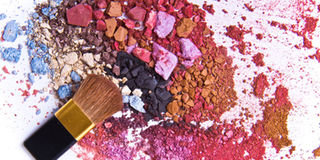Testimonies: how beauty products wrecked my skin

A make-up brush with broken cosmetic products. Photo | Web
What you need to know:
Beauty products such as lipstick pigments contain harsh chemicals that irritate skin and leads to blackening of lips or white patches around the area.
Make-up is no doubt most women’s daily morning routine, with the intention of improving appearance before kick-starting a day. But with fine aesthetics comes the other side of the story, are these beauty products safe?
One such case who spoke to Your Health is a 54-year-old woman, Mariam Said, who confessed that beauty products ruined her skin health.
She has been using a variety of such products, including bleaching agents and mixing of different products. Mariam’s skin now looks burnt.
So where did Mariam go wrong? She began using such products without consulting an aesthetician, instead she was led into trying different products by her friends and social netwoks, to get the results she wanted. But as the days went, her skin got a lot worse.
Upon asking her where she used to buy the products from, “I sometimes bought the products from small beauty kiosks which claimed that the products were imported from cross borders.”
She went on saying, “I always chose to ignore the labels because the chemical composition of the product never mattered to me, what was important at that time was only appealing results.”
Victims like Mariam at some point are influenced to use beauty products advertised through media, social networks and friend circles.
Why does the content in the beauty product matter
Speaking to health practitioner Dr Mwamvua Gugu on this subject, “Some of the beauty products, which are unauthorised are dangerous because of the chemical composition that have long term effects and can take years to show its effect on human body or skin.”
For instance, Dr Gugu exemplifies, skin lightning creams contain ingredients like chloroquinone, hydroquinone and mercury that specialists despise their use.
In trying to understand how the biology works in damaging the skin, Dr Gugu explains, “Our skin contains melanin which gives human skin its natural look. Dangerous chemical compositions and combinations reduces this pigment that makes the skin prone to altered look and diseases. The other factor is that human skin is said to contain normal flora (bacteria) that actually protects our skin from diseases, but long term use of such products kills these protective flora and the consequences are known.”
If people are aware, why do they still buy? A brief survey done by Your Health showed that most of the beauty products bought by the consumers are sold on the street whose minds are sullied by cheap prices and fair skinned models on the products.
According to Dr Sylvester Mathias, a retired officer from Tanzania Food and Drugs Authority (TFDA) based in Tabora region, says counterfeit drugs including cosmetics pose a public health hazard, waste consumer income, and reduce the incentive to engage in research and development and innovation.
Stronger state licensure supervision of drug suppliers would be helpful.
Let’s talk lipstick
The most important component in a woman’s make-up kit is undoubtedly the lipstick. No make-up kit is complete without one or many lipsticks, considering the different shades and brands.
In big cities like in Mwanza for example, there are specific shops commonly known as boutiques meant for selling ladies’ cosmetics.
Sophia Nyange, 29, a boutique owner in Mwanza city, says she makes quite a profit, bearing in mind that most of her customers are working ladies.
“Before opening this business, I was selling baby clothes. I came to realise that the business was not moving as expected and therefore got a clue from a friend over opening a make-up boutique,” she informs.
Sophia says she orders her goods from Nairobi after every one week. The goods sometimes get over before even the ordered ones arrive. “I spend about Sh2.5 million to make a single order from Nairobi but this does not hinder me because when a customer is in hurry, especially the wholesalers who take the lipstick and lip gloss varieties, can make advance payments,” she confesses.
While there are those who cannot go a day without wearing a lip shade, some don’t even own one.
24-year-old Pamela Juma, a resident of Geita region, tells Your Health she has been prohibited to use lipstick by her doctor, “Two years ago, I began using lipstick almost on an everyday basis of different brands but recently the area around my mouth developed rashes who advised me to stop using lipstick completely.”
But Pamela ridicules the advice by her doctor. She says that despite not applying the lipstick, her lips crack with blood. “My assumption is that over usage of lipstick makes the lip weak making its immunity low,” she says.
Pamela’s hypothesis is highlighted by Perpetua Hillary, a retired dermatologist based in Arusha who says that lipsticks come with its own inevitable side effects.
Women like Pamela wear lipstick when they leave home and continue wearing it all day long and sometimes even to bed.
“Altogether lipstick can cause allergy, irritation and chapping on the lips and the surrounding skin. Certain harmful chemicals and heavy metals can also cause cancer. Many lipsticks have petrochemicals as a common ingredient, which have harmful side-effects, for example these petrochemicals are a by-product of crude oil and natural gas. It can cause endocrine disruption that works as an obstacle for growth, development, reproduction and intelligence,” Dr Hillary cautions.
An expert’s outlook
Your Health had an opportunity to share the contradicting issue with Dr Mundil Trasi, a dermatologist at Hindu Mandal Hospital based in Mwanza. Dr Trasi discloses that lipsticks contain many harmful ingredients. These include chiefly toxic heavy metals like lead, cadmium, mercury and antimony. In addition to lead, lipsticks may contain formaldehyde, a preservative and known carcinogen, mineral oil substances are also known to block pores while parabens like carcinogens are often used as preservatives. Lipstick manufacturers are also using harmful petrochemicals to produce such lip formulas.
“Lead is the commonly found harmful content in lipsticks. It mainly affects the nervous system and harms the hormonal system. Lipsticks are known to cause allergy and irritation over the lips and the surrounding skin,” he informed.
He cited other harmful effects that are the blockage of pores, drying and chapping of lips. Certain harmful ingredients are known to cause cancer, also, heavy metal poisoning are present in minute quantities in our lipsticks.
Dr Trasi adds that lipstick pigments contain harsh chemicals that irritate the skin and lead to blackening of lips or on can even cause leukoderma due to melanocyte destruction.
Can one die if she digests the pigments on lipstick or lip gloss?
Lip formulas tend to be ingested after long hours of application, so the impact of the present toxins increases.
Researchers have found that average lipstick or lip gloss use resulted in women exceeding daily intake guidelines for aluminum, cadmium, chromium and manganese.
“These accumulate in your body over time and cause toxicity. Also, sleeping with lipstick increases the chances of all the harmful effects mentioned and hence, is to be strictly avoided,” warned Dr Trasi.


